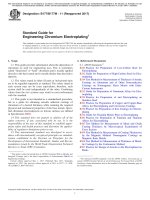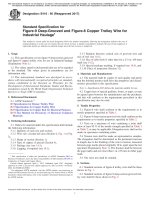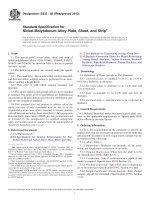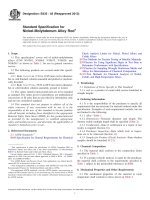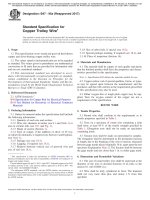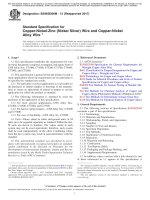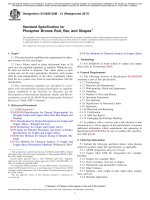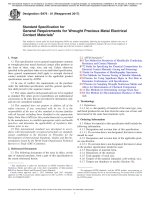Astm b 548 03 (2017)
Bạn đang xem bản rút gọn của tài liệu. Xem và tải ngay bản đầy đủ của tài liệu tại đây (111.23 KB, 5 trang )
This international standard was developed in accordance with internationally recognized principles on standardization established in the Decision on Principles for the
Development of International Standards, Guides and Recommendations issued by the World Trade Organization Technical Barriers to Trade (TBT) Committee.
Designation: B548 − 03 (Reapproved 2017)
Standard Test Method for
Ultrasonic Inspection of Aluminum-Alloy Plate for Pressure
Vessels1
This standard is issued under the fixed designation B548; the number immediately following the designation indicates the year of
original adoption or, in the case of revision, the year of last revision. A number in parentheses indicates the year of last reapproval. A
superscript epsilon (´) indicates an editorial change since the last revision or reapproval.
ization established in the Decision on Principles for the
Development of International Standards, Guides and Recommendations issued by the World Trade Organization Technical
Barriers to Trade (TBT) Committee.
1. Scope
1.1 This test method covers pulse-echo ultrasonic inspection
of aluminum-alloy plate of thickness equal to or greater than
0.500 in. (12.7 mm) for use in the fabrication of pressure
vessels. The ultrasonic test is employed to detect gross internal
discontinuities oriented in a direction parallel to the rolled
surface such as cracks, ruptures, and laminations, and to
provide assurance that only plate that is free from rejectable
discontinuities is accepted for delivery.
2. Referenced Documents
2.1 The following documents of the issue in effect on date
of material purchase form a part of this specification to the
extent referenced herein:
2.2 ASTM Standards:2
E114 Practice for Ultrasonic Pulse-Echo Straight-Beam
Contact Testing
E214 Practice for Immersed Ultrasonic Testing by the Reflection Method Using Pulsed Longitudinal Waves (Withdrawn 2007)3
E317 Practice for Evaluating Performance Characteristics of
Ultrasonic Pulse-Echo Testing Instruments and Systems
without the Use of Electronic Measurement Instruments
2.3 Other Standards:
ASNT Recommended Practice for Nondestructive Testing
Personnel Qualification and Certification—Ultrasonic
Testing Method—SNT-TC-1A4
1.2 The inspection method and acceptance criteria included
in this standard shall be limited to plate of the following
aluminum alloys: 1060, 1100, 3003, Alclad 3003, 3004, Alclad
3004, 5050, 5052, 5083, 5086, 5154, 5254, 5454, 5456, 5652,
6061, and Alclad 6061.
1.3 This test method applies only to ultrasonic tests using
pulsed longitudinal waves which are transmitted and received
by a search unit containing either a single crystal or a
combination of electrically interconnected multiple crystals.
Ultrasonic tests employing either the through-transmission or
the angle-beam techniques are not included.
1.4 This test method shall be used when ultrasonic inspection as prescribed herein is required by the contract, purchase
order, or referenced plate specification.
3. Summary of Method
3.1 The plate is inspected ultrasonically by scanning one
rolled surface with a beam of pulsed longitudinal waves which
is oriented in a direction perpendicular to the entry surface of
the plate. The ultrasound is transmitted into the plate either by
the direct contact, immersion, or liquid-column coupling
method. During the scan, an indication representing the first
back reflection is observed on the A-scan screen of the test
instrument.
1.5 The values stated in inch-pound units are to be regarded
as standard. The values given in parentheses are mathematical
conversions to SI units that are provided for information only
and are not considered standard.
1.6 This standard does not purport to address all of the
safety concerns, if any, associated with its use. It is the
responsibility of the user of this standard to establish appropriate safety and health practices and determine the applicability of regulatory limitations prior to use.
1.7 This international standard was developed in accordance with internationally recognized principles on standard-
3.2 When the test system sensitivity level is appropriately
adjusted, a discontinuity is detected during the scan by noting
2
For referenced ASTM standards, visit the ASTM website, www.astm.org, or
contact ASTM Customer Service at For Annual Book of ASTM
Standards volume information, refer to the standard’s Document Summary page on
the ASTM website.
3
The last approved version of this historical standard is referenced on
www.astm.org.
4
Available from American Society for Nondestructive Testing (ASNT), P.O. Box
28518, 1711 Arlingate Ln., Columbus, OH 43228-0518, .
1
This test method is under the jurisdiction of ASTM Committee B07 on Light
Metals and Alloys and is the direct responsibility of Subcommittee B07.03 on
Aluminum Alloy Wrought Products.
Current edition approved July 1, 2017. Published July 2017. Originally approved
in 1971. Last previous edition approved in 2009 as B548 – 03 (2009). DOI:
10.1520/B0548-03R17.
Copyright © ASTM International, 100 Barr Harbor Drive, PO Box C700, West Conshohocken, PA 19428-2959. United States
1
B548 − 03 (2017)
an isolated indication associated with a loss of the first back
reflection indication. The apparent size of the discontinuity is
determined by measuring the total area in the scanned entry
surface of the plate where the isolated indication and the loss
of back reflection persist. The estimated discontinuity size and
location are then compared with suitable acceptance criteria.
NOTE 2—For control purposes, the performance characteristics of the
test instrument and search unit may be established in accordance with
procedures outlined in Practice E317.
5.3 Tank—For tests by the immersion method, any container
is satisfactory that will facilitate the accurate, stable positioning of both the search unit and the plate to be inspected.
5.4 Scanning Apparatus—During the inspection procedure,
the search unit is supported by any one of the following
devices. The scanning apparatus shall permit measurement of
both the scan distance and the index distance within 60.1 in.
(62 mm).
5.4.1 Manipulator and Bridge—When a manipulator is used
in tests by the immersion method, the manipulator shall
adequately support a search tube containing a search unit and
shall provide fine adjustment of angle within 1° in two vertical
planes that are perpendicular to each other. The bridge shall be
of sufficient strength to provide rigid support for the manipulator and shall allow smooth, accurate positioning of the search
unit. Special search unit supporting fixtures may be used
provided they meet the requirements prescribed for a manipulator and bridge.
5.4.2 Liquid Coupling Nozzle—For tests by the liquidcolumn coupling method, the nozzle is usually positioned
manually and shall be capable of containing the couplant while
rigidly supporting the search unit with its active surface
immersed in the couplant. The couplant distance shall be
maintained so that the second couplant reflection is to the right
of the first back reflection on the instrument cathode ray tube
(CRT). The couplant path shall not vary more than 61⁄4 in.
(6.4 mm) during calibration, initial scanning, and discontinuity
evaluation. The recommended minimum inside dimension of
the nozzle is 1.0 in. (25 mm) greater than the maximum
dimension of the crystal surface in the search unit. Provisions
also should be included for adjustment of search unit inclination within 1° in two vertical planes that are perpendicular to
each other.
NOTE 1—Additional information describing ultrasonic tests by the
direct contact method and by the immersion method is available in
Practices E114 and E214.
4. Significance and Use
4.1 A number of factors such as the condition of the entry
and back surfaces of the plate, the inclination of the ultrasonic
beam with respect to the entry surface, and the performance
characteristics of the test system may cause either a reduction
of isolated indications or a substantial loss of back reflection
and thereby could seriously impair the reliability of the test
procedure outlined in this standard.
4.2 Accurate evaluations of discontinuity size also may be
limited significantly by variations in beam characteristics
which exist in most search units. For this reason, discontinuity
size as determined by the test procedure outlined in this method
is regarded as “apparent” or “estimated” in recognition of the
limited quantitative value of the measurement.
4.3 Because a large number of interacting variables in a test
system can adversely influence the results of an ultrasonic test,
the actual quantitative effects of detected discontinuities upon
the mechanical properties of the inspected plate are difficult to
establish. Consequently, this ultrasonic inspection method is
not applicable as an exclusive indicator of the ultimate quality
and performance of pressure vessels but provides a reliable
control of plate quality to avoid failure during the forming
process for fabrication of vessels.
5. Apparatus
5.1 Test Instrument—Any electronic device that produces
pulsed longitudinal waves and displays ultrasonic reflections
on an A-scan indicator when used with an appropriate search
unit is satisfactory. The instrument shall provide stable, linear
amplification of received pulses at a selected test frequency and
shall be free from significant interface signal interference at the
required sensitivity level.
NOTE 3—Nozzles containing either sealed or unsealed openings may be
used for inspecting plate provided the test results obtained with either
device are equivalent to those obtained by the immersion method.
5.4.3 Contact Scanning Unit—During tests by the contact
method, the search unit usually is supported and positioned
manually on the entry surface of the inspected plate. However,
special fixtures for contact scanning may be employed provided their use ensures conformance to the requirements in this
specification.
5.2 Search Unit—The search unit recommended for this
standard is the flat nonfocusing type, and contains a piezoelectric crystal which generates and receives longitudinal waves at
the rated frequency when connected to the test instrument
through a suitable coaxial cable. A dual-crystal search unit
containing both a transmitting and a receiving crystal in one
container may be used provided the test instrument will
accommodate two-crystal operation and the resulting pulseecho test is equivalent to that obtained with a search unit
containing a single-crystal.
5.2.1 The total effective area of the crystal or combination
of crystals in the search unit used for initial scanning shall not
be less than 0.4 in.2 (2.6 cm2) nor greater than 3.0 in.2 (19.4
cm2).
5.2.2 The effective diameter of the round search unit used to
evaluate discontinuity size shall not exceed 0.75 in. (19 mm).
5.5 Couplant—Clean, deaerated water at room temperature
is the recommended couplant for tests either by the immersion
method or by the liquid-column coupling technique. Inhibitors
or wetting agents or both may be used. For tests by the contact
method, the recommended couplant is clean, light-grade oil.
NOTE 4—Other coupling liquids may be employed for inspecting plate
provided their use does not adversely affect test results.
6. Personnel Requirements
6.1 The testing operator performing the ultrasonic examination prescribed in this standard shall be qualified and certified
2
B548 − 03 (2017)
8.4.2 During the scan, note the occurrence of isolated
discontinuity indications and monitor the amplitude of the first
back reflection by continuously observing the A-scan indicator
screen.
to at least a Level I—Ultrasonic Testing in accordance with the
ASNT Recommended Practice SNT-TC-1A.
6.2 The required documentation supporting qualification
and certification of ultrasonic testing operators shall be established by the certifying agency and shall be available upon
request by the purchaser.
NOTE 5—Auxiliary monitoring devices may be employed in the test
system to enhance detection reliability during the scan.
8.5 Scan Index—When the initial scan is completed, move
the search unit over a predetermined scan index distance in a
direction parallel to the predominant rolling direction of the
plate and proceed with a second scan along a line parallel to the
initial scanning direction while observing the test pattern on the
A-scan indicator screen. Calculate the scan index distance as
follows:
7. Condition of Plate
7.1 The entry and back surfaces of the inspected plate shall
be sufficiently clean, smooth, and flat to maintain a first back
reflection amplitude greater than 50 % of the initial standardization amplitude while scanning an area in the plate that does
not contain significant isolated ultrasonic discontinuities.
7.2 The inspected plate shall be at room temperature during
the test.
Scan index distance ~ in.! , S i 5 0.810.7 D s
(1)
Scan index distance ~ mm! , S i 5 2010.7 D s
(2)
where:
Ds = actual crystal diameter.
8. Procedure
8.1 Preferred Method—The ultrasonic test may be performed by either the liquid column coupling, the direct contact,
or the immersion methods. However, the immersion method is
preferred.
8.1.1 Maintain the couplant distance so that the second
couplant reflection is to the right of the first back reflection on
the instrument’s A-scan display. The couplant path shall not
vary more than 61⁄4 in. (6.4 mm) during calibration, initial
scanning, and discontinuity evaluation.
8.5.1 Continue the inspection by constantly observing the
test pattern on the A-scan indicator while successively scanning the plate at a constant scanning rate in a direction
perpendicular to the predominant rolling direction of the plate
and indexing the search unit through the index distance
calculated in 8.5.
8.5.2 During the inspection procedure, check the test system
sensitivity standardization periodically by noting the amplitude
of the first back reflection when the search unit is repositioned
over the reference area of the plate and by adjusting the
instrument gain control as required to maintain the sensitivity
standardization specified previously in 8.3.
8.2 Test Frequency—When using any of the three methods
listed in 8.1, the recommended test frequency is 5.0 MHz.
Other test frequencies between 2.0 MHz and 10.0 MHz may be
employed when necessary to minimize possible adverse effects
of plate thickness, microstructure, and test system characteristics upon test results and thereby maintain a clean, easily
interpreted A-scan screen pattern throughout the inspection.
8.6 Scanning Rate—When the screen pattern on the A-scan
indicator is monitored visually by the test operator during the
inspection, the scanning rate shall not be greater than 12 in./s
(305 mm/s).
NOTE 6—Scanning rates greater than 12 in./s (305 mm/s) may be
employed if auxiliary monitoring apparatus is used to maintain adequate
detection reliability.
8.3 Sensitivity Standardization—Standardize the sensitivity
level of the test system operating at the selected frequency by
adjusting the instrument gain control to obtain a first back
reflection amplitude of 75 6 5 % of the vertical limit exhibited
by the A-scan indicator when the search unit is positioned over
an area free from significant discontinuities in the plate to be
inspected. During tests by either the immersion method or the
liquid column coupling method, adjust the angular alignment
of the search unit to obtain a maximum number of back
reflections before the final sensitivity level is established.
8.7 Detection of Discontinuities—When an isolated ultrasonic indication of amplitude greater than 30 % of the A-scan
vertical limit is encountered or when the first back reflection
indication decreases to an amplitude less than 5 % of the
vertical limit at any time during the inspection procedure, stop
the scan and angulate the search unit to obtain a maximum
isolated indication and to determine that the loss of back
reflection is not caused by misalignment of the search unit with
respect to the plate.
8.7.1 To ensure that the loss of back reflection is not caused
by surface interference, check the condition of both the entry
and back surfaces of the plate at the location where a
substantial (95 % or greater) loss of back reflection occurs.
8.7.2 Either a maximized isolated ultrasonic indication exhibiting an amplitude greater than 50 % of the amplitude of the
initial first back reflection used for standardization, or a
substantial loss of the first back reflection indication not
attributable to either search unit misalignment or surface
interference, is an indication of an internal discontinuity.
8.4 Scanning—With no further adjustments of the instrument gain controls, locate the search unit over one corner of the
plate to be inspected so that the edge of the crystal in the search
unit is about 1 in. (25 mm) from either edge of the plate.
8.4.1 Subsequent to checking the angular alignment of the
search unit with respect to the rolled entry surface to ensure a
maximum first back reflection, proceed to scan the plate
continuously by moving the search unit at a constant scanning
rate (see 8.6) from the initial starting position to the opposite
edge in a direction perpendicular to the predominant rolling
direction of the plate.
3
B548 − 03 (2017)
(95 % or greater) exceeds 1.0 in. (25 mm), the discontinuity is
considered to be significant and the plate shall be subject to
rejection.
NOTE 7—Isolated indications occurring midway between the entry
surface indication and the first back reflection may cause a second
indication at the location of the first back reflection on the A-scan screen.
When this condition is verified by checking the multiple back reflection
pattern, a complete loss of the first back reflection can be assumed.
9.3 If the length of the marked area representing a discontinuity causing an isolated ultrasonic indication without a
complete loss of back reflection (95 % or greater) exceeds 3.0
in. (76 mm), the discontinuity is considered to be significant
and the plate shall be subject to rejection.
8.8 Estimation of Discontinuity Size—Note the location of
the search unit where the scan was stopped when either an
isolated indication or a loss of back reflection was observed.
8.8.1 Using a search unit containing a crystal of effective
diameter no greater than 0.75 in. (19 mm), make an evaluation
scan of an entire 6-in. (152-mm) square area which is centered
around the point on the plate entry surface where the scan was
discontinued. The recommended index distance for this evaluation is as follows: Si (in. or mm) = 0.7 Ds, where Ds is the
actual diameter of the search unit crystal.
8.8.2 To determine the apparent size of the discontinuity,
mark each location corresponding to the center of the search
unit on the plate entry surface where a 95 6 5 % loss of first
back reflection is observed or where the isolated indication
exhibits an amplitude equal to 50 6 5 % of the amplitude of
the initial first back reflection established during the standardization procedure outlined in 8.3.
8.8.3 Continue to mark the location of the search unit at
each point where either or both of the discontinuity conditions
specified in paragraph 8.8.2 are observed. The entire discontinuity shall be outlined even if it extends beyond the original
6-in. (152-mm) square evaluation scan area.
8.8.4 The estimated discontinuity size is the area defined by
the boundary consisting of successive marks as established by
this procedure.
9.4 If each of two marked areas representing two adjacent
discontinuities causing isolated ultrasonic indications without a
complete loss of back reflection (95 % or greater) is longer
than 1.0 in., and if they are located within 3.0 in. of each other,
the proximity between the two discontinuities is considered to
be significant, and the plate shall be subject to rejection.
NOTE 9—A template containing a 1.0-in. diameter hole and a 3.0-in.
diameter hole is a convenient device for rapidly establishing the significance of discontinuities. If the discontinuities described in 9.2 and 9.3
cannot be totally enclosed within either the 1.0-in. diameter circle or the
3.0-in. diameter circle, respectively, then the plate containing such
discontinuities shall be subject to rejection. Similarly, if any portions of
two adjacent discontinuities greater than 1.0 in. in length as in accordance
with 9.4 appear within the 3.0-in. diameter circle, the plate shall be subject
to rejection.
9.5 A plate containing significant discontinuities of rejectable size shall be acceptable if it is established by the purchaser
that the discontinuities will be removed from the plate by
machining during the subsequent fabrication process.
9.6 Upon specific consent of the purchaser, a plate with
significant discontinuities may be accepted if repaired by
welding.
NOTE 8—Automatic recording devices may be used to establish the
estimated size of a discontinuity provided the recorded results are
equivalent to those obtained by the procedure presented in 8.8.
10. Report
10.1 When required by the purchaser, a report shall be
prepared and shall include the date of test and a list of
parameters including the type (model number) of instrument
and search unit, the test method, frequency, and the couplant
employed for the inspection.
8.9 When the estimated size of a detected discontinuity is
determined, return the search unit to the original stopping
position and continue the initial scan to complete the inspection.
10.2 Preparation of a drawing showing the location of all
significant discontinuities in the inspected plate is recommended when the ultimate rejection or acceptance of the plate
is to be determined by negotiation between the manufacturer
and the purchaser.
9. Acceptance Standards
9.1 Upon completing the inspection procedure, measure the
longest dimension of each marked area representing a detected
discontinuity. Also, when an engineering drawing showing the
part to be fabricated from the plate is supplied, compare the
locations of the discontinuities with the dimensions on the
drawing.
10.3 The identification of an acceptable plate is desirable
and is recommended. For this purpose, a suitable stamp should
be employed to indicate conformance to this ultrasonic standard. The recommended stamp for identifying acceptable plate
is shown in Fig. 1.
9.2 If the longest dimension of the marked area representing
a discontinuity causing a complete loss of back reflection
4
B548 − 03 (2017)
FIG. 1 Stamp for Identifying Acceptable Plate
ASTM International takes no position respecting the validity of any patent rights asserted in connection with any item mentioned
in this standard. Users of this standard are expressly advised that determination of the validity of any such patent rights, and the risk
of infringement of such rights, are entirely their own responsibility.
This standard is subject to revision at any time by the responsible technical committee and must be reviewed every five years and
if not revised, either reapproved or withdrawn. Your comments are invited either for revision of this standard or for additional standards
and should be addressed to ASTM International Headquarters. Your comments will receive careful consideration at a meeting of the
responsible technical committee, which you may attend. If you feel that your comments have not received a fair hearing you should
make your views known to the ASTM Committee on Standards, at the address shown below.
This standard is copyrighted by ASTM International, 100 Barr Harbor Drive, PO Box C700, West Conshohocken, PA 19428-2959,
United States. Individual reprints (single or multiple copies) of this standard may be obtained by contacting ASTM at the above
address or at 610-832-9585 (phone), 610-832-9555 (fax), or (e-mail); or through the ASTM website
(www.astm.org). Permission rights to photocopy the standard may also be secured from the Copyright Clearance Center, 222
Rosewood Drive, Danvers, MA 01923, Tel: (978) 646-2600; />
5

